
It begins with a book, a map, then a man swimming to the shore of island. It is the most economical of openings to a film. The book tells us that this is a story of note, one that should automatically command our respect. The map tells us that what we are to witness is grounded in truth, because ostensibly its action can be found. The man is us.
Robinson Crusoe (Mexico 1954) is a distinct oddity among the works of the great Spanish director Luis Buñuel. It was made during his long sojourn in Mexico (1945-1961), after his startling debuts (Un chien Andalou, L’Age d’or) and before the creative triumphs of his latter years (Belle de Jour, The Discreet Charm of the Bourgeoisie). It was an exile of sorts but a commercial necessity as well, as Mexican producer Oscar Dancigers provided him with a relatively steady income. Buñuel worked to order, filming mostly in Spanish with local actors, and only occasionally producing works that were subversive or obviously challenging (Los Olivadados, El).
Of the twenty-one films he made in Mexico, Robinson Crusoe was one of two filmed in English. It was his first film in colour. It was clearly aimed at the global market and became a commercial success. Buñuel remembered the production of the film with some fondness, not least because of the challenges he overcame in filming over three months on a Pacific coast location, within budget. Though the story was not his choice and did not initially appeal to him, he became increasingly absorbed in his task. It became a Buñuel film. As he notes of his Mexican films in his memoir My Last Breath, “I never made a single scene that compromised my convictions or my personal morality”.
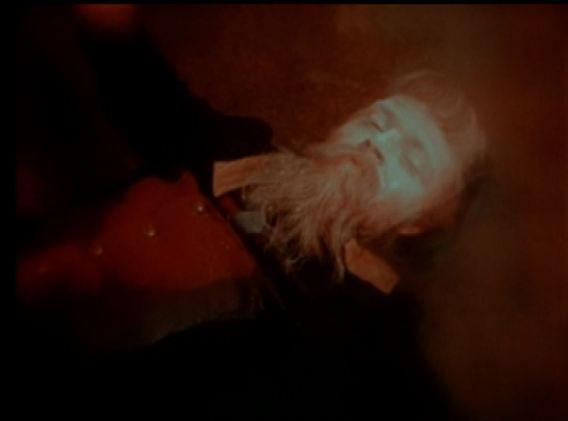
With all that said, it is difficult to see Robinson Crusoe as a ‘Buñuel’ film. Its style is ordinary, even mundane. There are some surreal or subversive elements that he was able to introduce, such as the feverish dream Crusoe has of his father, or Crusoe’s alarm at Friday clothed in a woman’s dress, but these are asides rather than anything integral to the design. Moreover, some of the most Buñuelian moments turn out to be taken directly from Defoe’s novel, as in this discussion Crusoe has with Friday about the devil:
After this, I had been telling him how the devil was God’s enemy in the hearts of men, and used all his malice and skill to defeat the good designs of Providence, and to ruin the kingdom of Christ in the world, and the like: “Well,” says Friday, “but you say God is so strong, so great, is he not much strong, much might, as the devil?” “Yes, yes,” said I, Friday, “God is stronger than the devil, God is above the devil, and therefore we pray to God to tread him under our feet, and enable us to resist his temptations, and quench his fiery darts.” “But,” says he again, “if God much strong, much might, as the devil, why God not kill the devil, so make him no more wicked?”
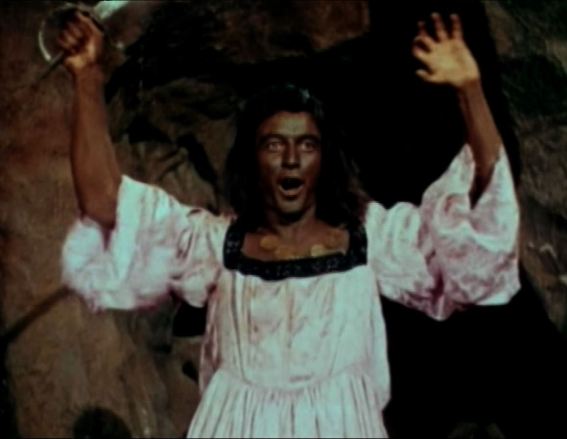
For the most part the film is dedicated towards relaying the story plainly, such as the producer required. It tells the story of Robinson Crusoe, mariner and would-be slave trader, who finds himself on a desert island, the sole survivor of a shipwreck. Thanks to materials left on the ship, and a good deal of enterprise on his part, Crusoe survives and lives well for many years. Though proud of what he achieves, he is haunted by his isolation, troubled at his failure to respect his father’s wishes, and much given to religious enquiry. After eighteen years he finds a footprint in the sand, subsequently rescuing a native Caribbean from cannibals, whom he names Friday. Friday becomes his servant and together they rescue some English sailors from mutineers. They leave the island to the imprisoned mutineers and take sail for England. (The novel goes on to describe the journey back, including a section where they fight off wolves in the Pyrenees, scenes that the film wisely ignores).
The film has first-person voiceover, as though Crusoe were reading from his own book. Much of the story is told through action rather than words, which gives the film its distinctive journalistic feel. Location dialogue is necessarily minimal until the latter stages of the film, when other characters emerge. For the most part what we see is a solitary man whose quest for survival, in a profound way, mirrors our own.
Such is the narrative and the overall method. Some have detected Buñuelian touches in the mise en scène; some have viewed it as a critique of Western imperialism, with its master and slave motif. One could consider the film as a metaphor for the director’s Mexican ‘exile’, cast away from the mainstream, kept going by a belief that he would eventually come into what was his own, in time. But none of this is obvious. It may be inferred, but Buñuel was not a filmmaker who traded on the elusive. His meanings may have been obscure, but they were never hidden. Robinson Crusoe is a different kind of film.
The key may lie in the origins of its story. Robinson Crusoe begins by showing us the novel from which its story derives. This is a common enough device from films of the period – indicting authenticity and cultural value by showing the audience the book the film seeks to emulate. But Robinson Crusoe seems, by its technique, to be doing more than this. It is not so much derived from Daniel Defoe’s novel as Defoe’s novel itself, as a pioneering work of fiction. If Defoe’s Robinson Crusoe is a first novel, of a kind, Buñuel’s Robinson Crusoe is a first film.

The Life and Strange Surprising Adventures of Robinson Crusoe, of York, Mariner was published in 1719. Its author, Daniel Defoe (1660-1731), was a journalist and commentator, of prodigious energy and output, who late in life wrote his first novel (he was fifty-nine when the book was published). It was, some have judged, the first modern novel. There are numerous candidates for proto-novels, in English, that came before Robinson Crusoe, of course: Thomas Malory’s Le Mort d’Arthur (1485), John Lyly’s Euphues (1578), Thomas Nashe’s The Unfortunate Traveller (1594), Margaret Cavendish’s The Blazing World (1666), or Aphra Behn’s Oroonoko (1688), among other possibilities. Notable candidates in other languages include Lady Murasaki’s The Tale of Genji (early 11th century) and Miguel de Cervantes’ Don Quixote (1605/1615). Each has novelistic qualities, but does not quite make the mark by being episodic, or allegorical, or fantastical, or too short, or simply lacking in the unity of purpose that one associates with the modern novel.
Robinson Crusoe was different. Ian Watt, in his peerless study, The Rise of the Novel, argues that what was new about the eighteenth-century long fictions of Defoe, Samuel Richardson and Henry Fielding was their realism, by which he means that they attempt “to portray all the varieties of human experience, and not merely those suited to one particular literary perspective: the novel’s realism does not reside in the kind of life it presents, but in the way it presents it.” Further, it is the individualistic nature of such fiction, in which the protagonist discover the world, and hence truth, through what they are able to apprehend for themselves, that makes Robinson Crusoe, Moll Flanders, Pamela and Tom Jones so revolutionary. Simplistically put, they replaced the incredible with the credible, the mythic with the secular.
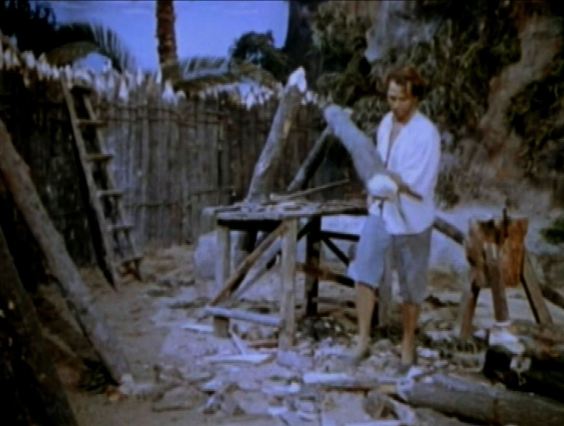
The protagonists of such narratives, do not just appear, fully grown, but have come from somewhere that positions them in a recognisable human and individual situation. One of Defoe’s great contributions to the novel was the childhood back story. In his novel Moll Flanders (1722), the title character not only recounts the first years of her life but admits that her memories can only be hazy about her first years. It is a small, but revolutionary, innovation:
The first account that I can recollect, or could ever learn of myself, was that I had wandered among a crew of those people they call gypsies, or Egyptians; but I believe it was but a very little while that I had been among them, for I had not had my skin discoloured or blackened, as they do very young to all the children they carry about with them; nor can I tell how I came among them, or how I got from them.
Robinson Crusoe opens with the irregularity of one man’s background that says that here is no allegorical or universal figure, but an individual, rooted in his own times:
I was born in the year 1632, in the city of York, of a good family, though not of that country, my father being a foreigner of Bremen, who settled first at Hull: he got a good estate by merchandise, and leaving off his trade, lived afterwards at York, from whence he had married my mother, whose relations were named Robinson, a very good family in that country, and from whom I was called Robinson Kreutznaer; but by the usual corruption of words in England, we are now called, nay we call ourselves, and write our name Crusoe, and so my companions always called me.
I had two elder brothers, one of which was lieutenant-colonel to an English regiment of foot in Flanders, formerly commanded by the famous Colonel Lockhart, and was killed at the battle near Dunkirk against the Spaniards. What became of my second brother I never knew, any more than my father or mother did know what was become of me.
It is that small detail of the lost second brother that announces Defoe’s genius. It is irrelevant and essential, the promise of another novel that someone else, one day, might take in hand. It is the accidental poetry that comes with identity.
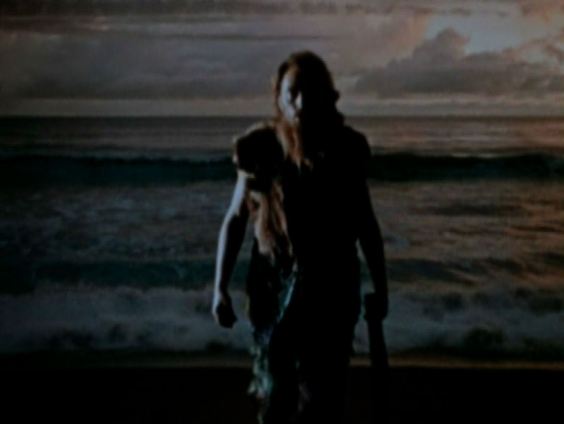
Luis Buñuel’s Robinson Crusoe is set within this realist framework. His Crusoe (played by Dan O’Herlihy) may arrive on the island as though some idealistic, representative figure, but he has individuality and authenticity, those elements that Watt sees as crucial to the modern novel. Crusoe is an ordinary person in extraordinary circumstances.
Buñuel, however, has to simplify. Defoe starts with Crusoe’s childhood, the break from his father, his maritime adventures and capture by Moorish slavers, before he survives the shipwreck that is making of him as a narrative hero. Buñuel must follow the logic of film and begin with this supporting material reduced to reminiscences once Crusoe is on the island, and to the phantasmagorical visions of the father that seem the most Buñuelian aspect of the film. Gone also are the prolonged sections in which the business-like Crusoe accounts for his efforts. Defoe was proud of his economic analyses, and Watt finds ‘economic individualism’ crucial in explaining his character (Crusoe sees the world as something he should exploit). But though relevant to any understanding of Crusoe as a modern man, the film viewer does not need them. The film must promise actions and their consequences.
Defoe’s Crusoe is a man of his times, whose understanding is shaped by the politics and religious understanding of the period. Buñuel’s Crusoe is far less a figure tied to any time at all, though one would be hard-pressed to see him as a twentieth-century person. There is a combination of the realistic and the symbolic in both of them. Tom Paulin, in his book on the Dissenting tradition in English literature, Crusoe’s Secret, argues strongly for Crusoe as driven by the contentions of his time, but nevertheless notes that Defoe called his novel a ‘parable’, drawing our attention to Crusoe’s words in one of the novel’s sequels (Defoe wrote two of them): “the Story, though Allegorical, is also Historical”. The only difference between novel and film, in this regard, is that Defoe’s readers had experienced those times, while Buñuel’s viewers can only understand them at a distance.
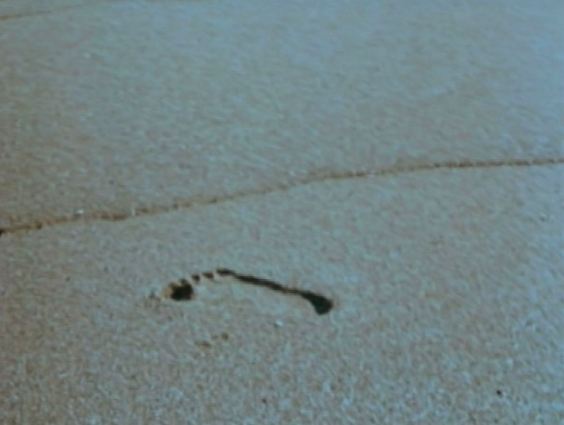
Another point of comparison, one which is crucial to the ‘first film’ conceit, is that of style. Daniel Defoe was the master of good plain prose. It may bear some complex ideas, or at least richness of ideas that the author is so keen to put across, but what must strike the reader most is the observational clarity of his words. He needs us to see what Crusoe sees, as in this famous passage in which Crusoe discover that he is not alone on his island:
It happened one day about noon, going towards my boat, I was exceedingly surprised with the print of a man’s naked foot on the shore, which was very plain to be seen in the sand: I stood like one thunder-struck, or as if I had seen an apparition; I listened, I looked round me, I could hear nothing, nor see any thing; I went up to a rising ground to look farther: I went up the shore, and down the shore, but it was all one, I could see no other impression but that one; I went to it again to see if there were any more, and to observe if it might not be my fancy; but there was no room for that, for there was exactly the very print of a foot, toes, heel, and every part of a foot; how it came thither I knew not, nor could in the least imagine. But after innumerable fluttering thoughts, like a man perfectly confused, and out of myself, I came home to my mortification, not feeling, as we say, the ground I went on, but terrified to the last degree, looking behind me at every two or three steps, mistaking every bush and tree, and fancying every stump at a distance to be a man; nor is it possible to describe how many various shapes an affrighted imagination represented things to me in; how many wild ideas were formed every moment in my fancy, and what strange unaccountable whimsies came into my thoughts by the way.
Buñuel’s Robinson Crusoe is good plain prose in film. It is, for the most part, clear, unadorned, observational, passive to a degree. It is intent on telling the story. In My Last Breath Buñuel reveals little about his approach to the film, noting only that he overcame initial scepticism for find interest in the story, to which he was able to add some imaginary elements (that is, augmenting the story, but not altering it). In an interview he reportedly said that he did not care for the novel but liked Crusoe (which is a paradoxical argument – Crusoe’s character is the novel). According to Dan O’Herlihy, whose advocacy of the film helped it gain attention (he was nominated for a Best Actor Academy Award), Buñuel saw the film as being “a psychological study of a man with an aging, crumbling mind. Suddenly he meets Friday as an eccentric, and the mind rights itself”. The film does indeed pivot on the moment when Crusoe comes to his senses and asks Friday’s forgiveness for earlier mistreatment, but it’s not much of an interpretation. I sense, instead, that Buñuel saw little need to interpret the story at all. Its strength lay in its obviousness.

Robinson Crusoe is just about the best idea anyone every had for a story. Perhaps only Don Quixote and Hamlet equal it. It places someone – who could be any one of us – alone in the world, surrounded by water, helpless, and asks what we are made of. It is simultaneously the ultimate fantasy of escape and peril. The age of transatlantic voyages and the imperialist ventures that followed had introduced readers to the idea of remote islands with unknown societies, or else islands no human had visited, making the reader wonder what would happen if someone, or if they, were the person to first set their foot upon those untouched sands. William Shakespeare analysed the paradoxes of the island fantasy with great profundity in The Tempest (intriguingly, Buñuel’s film has a possible tribute to The Tempest – part of the wrecked ship bears the name ‘Ariel’, which does not feature in the novel). Defoe turned allegorical fantasy into journalistic fiction. Robinson Crusoe built on stories of genuine castaways, most notably Alexander Selkirk, who survived alone on an uninhabited South Pacific island between 1704 and 1709. Defoe’s novel reads like an actual survivor’s tale. It is allegory made real.
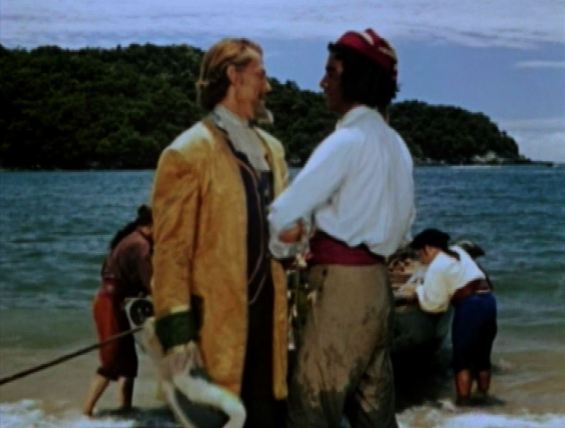
So where does the ‘first film’ idea come in? Obviously Robinson Crusoe was released sixty years after the first motion picture films were projected, but chronology is not what matters here. Robinson Crusoe has the purity of a work where storytelling through film has been found for the first time. It is a creation, much like its protagonist, that lands in a strange place, looks about its domain, and finds mastery through its observation. It seems that what this new medium can do is make the real become fantastical, and the fantastical become real. It comments only on itself, but promises all that can now follow. Buñuel does not so much invent the medium as take it back to its first principles. Film can start from here.
Robinson Crusoe is a plain film. That it is not an entirely satisfactory film is for purely technical reasons, the muddy look of the Pathe Color stock dissipating some of the film’s engaging qualities. These include Dan O’Herlihy’s affecting performance, as he turns from muddled castaway to the king of his own island (the imperialist message that underpins the story comes across most clearly when those that encounter Crusoe towards the end of the film recognise him as their natural leader). Jaime Fernández is a spirited and subtly-crafted Friday, whose bright-eyed discovery of the new world about him mimics that of Crusoe (sadly, though, his skin was clearly blackened for the role). The settings, with their precise details of how Crusoe builds up his world, delight in the same way that the illustrations in children’s books of old always delighted. The film charms and intrigues and engrosses us.
Yes, it is fusty, but only in the way that some old pages now curl. The story still reads the same, and Robinson Crusoe tells the best of stories. Someone from somewhere lands on an uninhabited island, and no one knows that they are there. They are magnificently alone. Now what do I do?
Links:
- Robinson Crusoe is available on DVD under its alternative title, Adventures Of Robinson Crusoe. All of the images in this post are screengrabs from the DVD. Its original, Mexican release title is Las Aventuras de Robinson Crusoe (the film was shot simultaneously in English and Spanish versions). I included the film in my top ten choices for the 2022 Sight & Sound ‘greatest films of all time’ poll.
- Luis Buñuel’s autobiography, My Last Breath, is a delight. Warmly recommended.
- Ian Watt’s The Rise of the Novel: Studies in Defoe, Richardson and Fielding (1957) is as gripping a read as any novel. Its ideas feel as fresh as ever they did.
- The Dan O’Herlihy quote is from Howard Thompson, ‘Of People and Pictures”‘, The New York Times, 11 July 1954, p. 5. The reference to Buñuel preferring the character of Crusoe to the novel is cited in Sean Axmaker’s useful account of the film’s production and themes for TCM in 2014, available via the Wayback Machine.
- Tom Paulin’s insightful essay ‘Crusoe’s Secret: Daniel Defoe’ is in his collection of essays Crusoe’s Secret: The Aesthetics of Dissent (Faber, 2005).
- The words “the Story, though Allegorical, is also Historical” come from the strange second sequel Serious Reflections During the Life and Surprising Adventures of Robinson Crusoe: With his Vision of the Angelick World (1720). This was preceded by the rather odd The Farther Adventures of Robinson Crusoe (1719), in which Crusoe and Friday return to the island (where Friday is killed), after which Crusoe journeys to Madagascar, Southeast Asia and Siberia. Both works are strictly for the specialists.
- ‘Ariel’ is also he name of a Mexican film industry award.